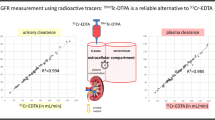Abstract
A multicentre European study was undertaken in order to determine a reasonable algorithm allowing the determination of overall technetium-99m mercaptoacetyltriglycine clearance using a single blood sample. Employing multiple blood sample clearance as a reference method, it was shown that an acceptable estimation of the MAG3 renal clearance could be obtained using a blood sample taken at any time between 30 and 40 min after tracer injection. After correction for body surface area, comparison of clearance determined using (a) the single blood sample and (b) the multiple blood samples provided a coefficient of correlation of 0.949 and an SEE of 27 ml/min. This algorithm is valid for clearance values higher than 100 ml/min/1.73 m2 and for children older than 1 year of age.
Similar content being viewed by others
References
Tondeur M, Piepsz A, Dobbeleir A, Ham HR. Technetium 99m mercaptoacetyltriglycine gamma camera clearance calculation: methodological problems. Eur J Nucl Med (1991) 18:83–86.
Claessens RAMJ, Corstens FHM. Tc-99m MAG3 clearance determined in patients by simplified methods. J Nucl Med 1989; 30:943.
Russel CD, Bisschoff PG, Kontzen N, Rowell KL, Yester MV, Lloyd K, Tauxe WN, Dubovsky EV. Measurement of glomerular filtration rate: single injection plasma clearance method without urine collection. J Nucl Med 1985; 26:1243–1247.
Christensen AB, Groth S. Determination of 99m Tc-DTPA clearance by a single plasma sample method. Clin Physiol 1986; 6:579–588.
Tauxe WN, Hagge W, Stickler GB. Estimation of effective renal plasma flow in children by use of a single plasma sample after injection of orthoiodohippurate. In: Dynamic studies with radioisotopes in medicine, vol I. Vienna: International Atomic Energy Agency 1974:265–275.
Groth S, Aasted M. 51Cr-EDTA clearance determined by one plasma sample in children. Clin Physiol 1984; 4:75–83.
Tauxe WN, Bagchi A, Tepe PG, Krishnaiah PR. Single sampled method for the estimation of glomerular filtration rate in children. J Nucl Med 1987; 28:366–371.
Ham HR, Piepsz A. Estimation of glomerular filtration rate in children using a single — plasma sample method. J Nucl Med 1991; 32:1294–1297.
Sapirstein LA, Vidt DG, Mandel MJ, Hanusek G. Volumes of distribution and clearances of intravenously injected creatinine in the dog. Am J Physiol 1955; 181:330–336.
Müller-Suur C, Müller-Suur R. Handling of 99mTc-MAG3 in the kidney. Contrib Nephrol 1990; 79:17–20.
Russel CD, Taylor A, Eshima D. Estimation of technetium-99m-MAG3 plasma clearance in adults from one or two blood samples. J Nucl Med 1989; 30:1955–1959.
McGuire EAH, Helderman JH, Tobin JD, Andres R, Berman M. Effects of arterial versus venous sampling in analysis of glucose kinetics in man. J Appl Physiol 1976; 41:565–572.
Author information
Authors and Affiliations
Rights and permissions
About this article
Cite this article
Piepsz, A., Gordon, I., Hahn, K. et al. Determination of the technetium-99m mercaptoacetyltriglycine plasma clearance in children by means of a single blood sample: a multicentre study. Eur J Nucl Med 20, 244–248 (1993). https://doi.org/10.1007/BF00170006
Received:
Revised:
Issue Date:
DOI: https://doi.org/10.1007/BF00170006




